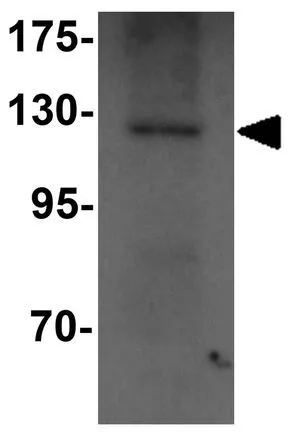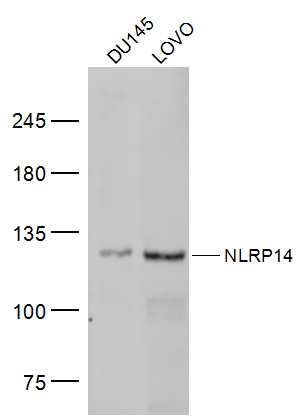
WB analysis of rat brain tissue lysate using GTX85152 NALP14 antibody. Working concentration : 1 microg/ml
NALP14 antibody
GTX85152
ApplicationsWestern Blot, ELISA
Product group Antibodies
TargetNLRP14
Overview
- SupplierGeneTex
- Product NameNALP14 antibody
- Delivery Days Customer9
- Application Supplier NoteWB: 1 microg/mL. *Optimal dilutions/concentrations should be determined by the researcher.Not tested in other applications.
- ApplicationsWestern Blot, ELISA
- CertificationResearch Use Only
- ClonalityPolyclonal
- Concentration1 mg/ml
- ConjugateUnconjugated
- Gene ID338323
- Target nameNLRP14
- Target descriptionNLR family pyrin domain containing 14
- Target synonymsCLR11.2, GC-LRR, NALP14, NOD5, PAN8, NACHT, LRR and PYD domains-containing protein 14, NACHT, LRR and PYD containing protein 14, NACHT, leucine rich repeat and PYD containing 14, nucleotide-binding oligomerization domain protein 5, nucleotide-binding oligomerization domain, leucine rich repeat and pyrin domain containing 14
- HostRabbit
- IsotypeIgG
- Protein IDQ86W24
- Protein NameNACHT, LRR and PYD domains-containing protein 14
- Scientific DescriptionNALP proteins are cytoplasmic proteins that form a subfamily within the larger CATERPILLER family and are thought to play a crucial role in cell proliferation and reproduction. Like all other NALP family members, NALP14 has a C-terminal leucine-rich repeat (LRR) region, an N-terminal Pyrin domain (PYD) followed by a NACHT domain, and a NACHT-associated domain. While little is known about the function of NALP14, it has been suggested that it may play a role in spermatogenesis and that mutations in the NALP14 gene might cause spermatogenic failure.
- Storage Instruction-20°C or -80°C,2°C to 8°C
- UNSPSC12352203





